Collingwood, On – Honda’s ubiquitous compact crossover is no stranger to the Canadian motoring public. With sales reaching more than 34,000 units in the Great White North last year, the number of new CR-Vs being parked in Canadian garages has been on an upward trajectory since 2009.
Even on the cusp of a significantly refreshed 2015 model reaching dealerships, the 2014 model still proved to be the third most popular compact SUV in the land in August of this year.
The CR-V is no stranger to Autos.ca either. We have scrutinized and re-examined the little ute numerous times during road tests, long-term tests and comparison tests where it has continuously placed at the top or near the top of our charts in every instance.
Not being ones to rest on their laurels, Honda has taken the beloved CR-V and given it a significant mid-cycle refresh, addressing a number of key issues identified to be weak points against the competitors and making it more efficient, more functional and more confident on the road.
For starters, and most significantly, the CR-V’s drivetrain has undergone a significant update providing an improvement to both efficiency and performance. While a 2.4L inline-four cylinder is still the only mill Honda offers for the CR-V, this new one lifted from the Accord, now produces 181 lb-ft of torque, up 11 percent from a somewhat anemic 163 in last year’s model.
Maximum power (185 hp) is achieved 600 rpm sooner than in last year’s engine, now at 6,400 rpm. The new engine is a higher compression unit with direct injection and reduced internal friction resulting in the torque increase and greater power throughout most of the rev range up to 7,000 rpm.
This Earth Dreams engine is also mated to an all-new CVT transmission, replacing the outdated and comparably inefficient five-speed automatic. While driving enthusiasts generally bemoan the implementation of a CVT, the reality is these systems are efficient and becoming far more prevalent in the automotive universe. Honda is one of only a few builders that has does a really good job of their CVTs in the past and the unit found in the CR-V is also a good one.
That said, Honda’s product manager promoted a simulated downshift feature with this new transmission that I rarely experienced out on the road. Instead, the dreaded CVT “mooing” was occasionally present with judicious prods of the accelerator pedal.
The newfound torque and more usable power delivery are appreciated in daily driving situations, enabling the CR-V to get up to speed and pass safely to suit most people’s needs. This may also help potential buyers choose the Honda who might have otherwise been leaning toward a more energetic Toyota RAV4 or Mazda CX-5.
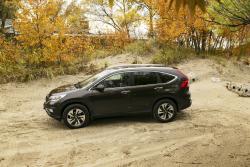 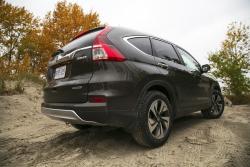 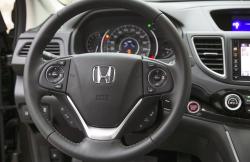 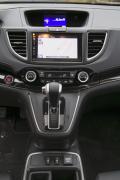 2015 Honda CR-V, steering wheel, centre stack. Click image to enlarge |
Out on a scenic drive Honda set up for us around the rural routes near Collingwood, Ontario, the new CR-V is pleasant enough and a satisfying improvement over the outgoing model in terms of its drivability. With new door sealing, carpet insulation and sound-absorbing material usage throughout the car, the 2015 CR-V is claimed to be the quietest in the class. I can attest that wind and road noise are both impressively suppressed, though engine noise still makes itself known.
Honda claims the new mechanical changes to the engine and transmission will vault the CR-V to the head of the class for fuel efficiency too. The 2WD version is rated at 8.6 L/100 km city (versus 10.3 last year) and 6.9 highway (versus 7.6). For the 4WD version, owners are looking at 9.1 city (versus 10.6) and 7.2 highway (7.9). In all instances, the improvements are significant enough to warrant kudos to Honda’s engineers.
Honda’s Real Time All Wheel Drive system continues to be available on each of the CRV’s three trim levels. This is a system that enables the rear wheels to rest until they’re needed, sending power back only when slippage is detected. Honda chooses this method over a full-time AWD system in the interest of reducing drivetrain lag and thus, saving fuel.
The styling of the CR-V has not been its strongest suit for the past few generations and Honda has updated the look for 2015 with a new grille and headlight treatment. The tail end has also received some updates to help give a wider, more squat appearance. 18-inch wheels are now offered on higher trim levels for the first time.
Technology is another area of significant improvement in the updated CR-V. The overly convoluted infotainment system on the previous model was criticized repeatedly by the Autos.ca team. The new system with Honda’s tablet-like 7-inch touch screen display unit was first seen on the 2014 Civic and 2015 Fit. For the most part, the new system is a dramatic improvement for usability thanks to pinch-and-squeeze functionality on the touchscreen, plus a more intuitive menu layout.
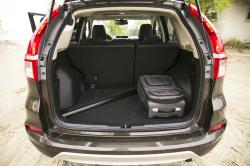  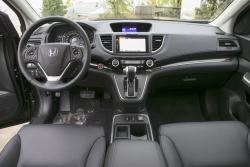 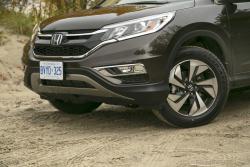 2015 Honda CR-V seating, cargo area. Click image to enlarge |
We have complained about the lack of a proper volume knob for this system in the Fit and Civic, and it seems someone was listening at Honda since there’s now a single row of actual buttons down the left side of the screen, including some for volume adjustment. While we’d prefer the simplicity of an actual volume knob, this is a slight improvement.
Honda is also making considerable efforts to increase the safety of the CR-V. The celebrated LaneWatch system whereby a camera mounted to the passenger side mirror shows what lurks in the blind spot has now shown up on the CR-V. More impressive is Honda’s decision to include their Honda SENSING suite on the top-level Touring trim CR-V. Adaptive Cruise Control, Lane Keeping Assist System and Collision Mitigation Braking System are all high-tech safety features normally associated with high-end luxury vehicles, but they are part of this package. Curiously during our drive the camera based Lane Keeping Assist System failed to do its job when the asphalt surface became faded and the contrast between it and the painted lines diminished.
The folks at Honda expect their hard work on the safety front will net the CR-V a top safety pick rating, plus a “Superior” designation for Front Crash Prevention.
This new, more efficient, more responsive and safer CR-V is also a better value. Despite the new and improved drivetrain, the entry-level LX remains at the same price point. The rest of the line up sees no more than a few hundred dollars added to the bottom line, but at the top level Touring, nearly $3,000 of value is added to the car through the new features and updates that are made standard.
 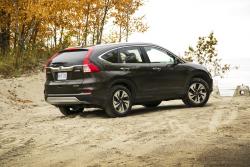  CR-V generations (left). 2015 Honda CR-V (middle and right). Click image to enlarge |
In our books, Honda has had a winner with the CR-V for a while. Now with the considerable mechanical and technological improvements added to Honda’s compact SUV, a very good crossover has been made better.
|
Manufacturer’s Website: Honda Canada Photo Gallery: Crash Test Results: |
Pricing: 2015 Honda CR-V
LX 2WD: $25,990
LX 4WD: $28,350
SE: $29,790
EX: $31,790
EX-L: $33,790
Touring: $35,790
Competitors:
Chevrolet Equinox
Jeep Cherokee
Ford Escape
Hyundai Santa Fe Sport
Kia Sportage
Mazda CX-5
Nissan Rogue
Subaru Forester
Toyota RAV4
Volkswagen Tiguan















